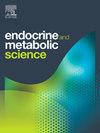Optimizing pre-genetic diagnosis of monogenic diabetes: clinical thresholds for targeted testing
Q3 Medicine
引用次数: 0
Abstract
Background
Monogenic Diabetes Mellitus (MDM) represents a minority of Diabetes Mellitus (DM) cases but poses diagnostic complexities owing to its clinical overlap with other forms of DM. Preliminary clinical screening is crucial for diagnosis due to the paucity of genetic testing facilities.
Aim
We aimed to identify clinical thresholds that could enhance the likelihood of obtaining positive genetic test results while excluding young-onset T2DM in suspected cases of MDM.
Methodology
We analyzed the demographic, anthropometric, and biochemical details of genetically confirmed MDM participants (n = 10) from our center and compared them with those of clinically suspected patients who tested negative for MDM (n = 67), excluding two neonatal DM (NDM) cases. Using Receiver Operating Characteristic curves, we determined the thresholds for various parameters, prioritizing a sensitivity of ≥75 %.
Results
The upper cut-off values obtained for identifying individuals with a potential for genetic positivity were age of onset of DM 25.5 years, BMI 23.5 kg/m2, visceral fat 7 %, waist circumference (irrespective of gender) 86 cm, random C-peptide 1.41 ng/mL, AST 31 units/dL, ALT 41 units/dL, triglyceride 150 mg/dL, and for HDL, the lower cut-off point was 48.5 mg/dL.
Conclusion
These defined thresholds offer a potential to enhance the efficient use of genetic testing by ensuring more targeted utilization, thus optimizing resource allocation and improving diagnostic accuracy in the assessment of MDM.
优化单基因糖尿病的遗传前诊断:靶向检测的临床阈值
背景单基因糖尿病(MDM)占糖尿病(DM)病例的少数,但由于其与其他形式的DM的临床重叠,使诊断变得复杂。由于缺乏基因检测设施,初步的临床筛查对诊断至关重要。我们旨在确定临床阈值,以提高获得阳性基因检测结果的可能性,同时排除疑似MDM病例中年轻发病的T2DM。方法:我们分析了我们中心遗传证实的MDM参与者(n = 10)的人口学、人体测量学和生化细节,并将其与临床疑似MDM阴性患者(n = 67)进行比较,不包括2例新生儿DM (NDM)病例。使用受试者工作特征曲线,我们确定了各种参数的阈值,优先考虑灵敏度≥75%。结果识别潜在遗传阳性个体的上限临界值为DM发病年龄25.5岁,BMI 23.5 kg/m2,内脏脂肪7%,腰围(不分性别)86 cm,随机c肽1.41 ng/mL, AST 31单位/dL, ALT 41单位/dL,甘油三酯150 mg/dL, HDL的下限临界值为48.5 mg/dL。结论这些定义的阈值有可能通过确保更有针对性的利用来提高基因检测的效率,从而优化资源分配,提高MDM评估的诊断准确性。
本文章由计算机程序翻译,如有差异,请以英文原文为准。
求助全文
约1分钟内获得全文
求助全文
来源期刊

Endocrine and Metabolic Science
Medicine-Endocrinology, Diabetes and Metabolism
CiteScore
2.80
自引率
0.00%
发文量
4
审稿时长
84 days
 求助内容:
求助内容: 应助结果提醒方式:
应助结果提醒方式:


